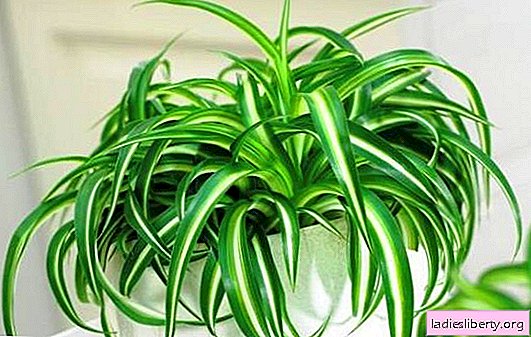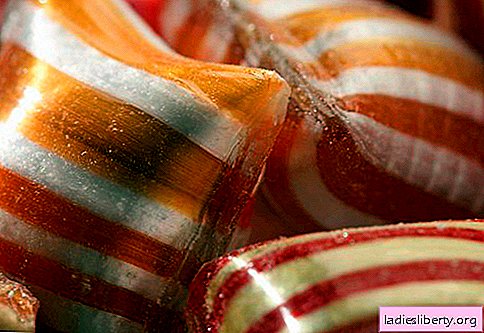
Chlorophytum is one of the most unpretentious and useful indoor plants.
A perennial herbaceous flower has a rosette of linear drooping leaves.
With good care, the plant will thank the owner with baskets of flowers.
Growing chlorophytum is a pleasure, because it is not for nothing that people call it "indoor weed".
However, the flower won universal love not only with ease of care, but also with its beneficial properties.
An adult plant is able to purify the air, destroy bacteria and germs. It is widely grown in institutions, hospitals and enterprises.
Due to all its qualities, chlorophytum deserves special attention and is a worthy contender for growing at home.
Chlorophytum cultivation: about everything related to planting (photo)
In indoor floriculture, many species of this amazing flower are known, but some of them are especially fond of gardeners. Most often, variegated species of chlorophytum are grown at home: the leaves of the plant have white stripes and edges. Landing of all varieties is the same. It is carried out by dividing the old bush or by rooting young outlets. Young plants quickly take root and start to grow. The best time for planting a flower is spring or summer days.
Selects a location for the plant
Chlorophytum is designed to cleanse the room of harmful compounds, so the best place for it is the kitchen. Almost all plant varieties love the sun, but they should be shaded from direct rays. The flower also feels great in the shade, but variegated species with this placement lose their decorative effect. It is best to place the pot with chlorophytum on the east or west window.
Providing chlorophytum enough light for growth and development, the plants will delight the magnificent appearance, juicy green leaves and abundant flowering. If the flower does not have enough light, then this can be seen by its appearance:
• the tips of the leaves turn yellow;
• slow growth;
• variegated leaves turn pale.
Chlorophytum pot size
The plant is distinguished by its rapid growth, some time after planting, chlorophytum turns into a chic bush. The planting pot should be spacious, but shallow. The flower will feel good in low cups. The material from which the pot is made is of great importance when planting chlorophytum. Clay containers will not work, since the earth in them quickly dries, which harms the root system of the plant. It is better to give preference to plastic or ceramic containers. Chlorophytum will look good in hanging pots or in a pot with palm trees. The flowerpot material should be fairly strong, as the plant has a powerful root system and can split it.
What soil does the plant need?
Chlorophytum is undemanding to soils, grows well in universal soils for indoor plants. Experienced gardeners prefer to prepare a substrate for planting a flower on their own. To do this, mix two parts of leaf humus, earth with one part of sand. The main soil requirement for planting chlorophytum is friability. Ready soil should pass water well, avoiding its stagnation near horses, which is detrimental to the plant.
When to transplant chlorophytum?
Young plants need frequent transplants, which are done several times a season. A planned transplant of an adult flower is carried out in the spring.
Carrying out the procedure, you need to carefully inspect the roots of the plant, remove all damaged and dry parts. The state of the roots at the time of transplantation will tell you about the health of the plant.
• If there are thickenings on the roots, this indicates insufficient watering.
When placing a flower in a new spacious pot, it is necessary to cut its roots to 1/3 of the length. This procedure does not harm the plant, but allows it to quickly take root in a new place.

How to understand that the time has come to transplant chlorophytum?
1. If the plant occupies the entire area of the pot, has grown greatly and it is clearly visible that it is crowded, then you need to transplant.
2. If the roots are already visible in the holes for the water drain, then it is impossible to tighten with transplantation.

A new pot is selected in size larger than the previous one by several centimeters. Ideally, the root system of the flower should be located in it freely, to the bottom there is a space of 4-5 cm.
Chlorophytum care: watering, top dressing, temperature
Any plant feels good in comfortable conditions for growth and development, chlorophytum is no exception. Creating suitable conditions for the flower is simple.
Temperature conditions for growing
The herbaceous plant is not whimsical to the temperature regime, but in winter it can get sick in a cold room. The optimal temperature for keeping the flower in winter will be +18 degrees. In the summer, it is useful to take the flower out into the fresh air, but protect it from the scorching sun. The temperature in the room for growing should be within +25 degrees.
Important! The plant must not be exposed to cold air and drafts. Therefore, in winter, you need to carefully ventilate the room.
Air humidity
Chlorophytum loves high humidity. In summer, frequent spraying and a warm shower are helpful. In winter, the frequency of spraying is reduced. If the flower pot is located nearby with central heating, then you need to irrigate the plant in the winter.
With insufficient moisture, chlorophytum is often sick, the decorativeness of the flower is lost: the ends of the leaves dry out and die. You can increase the humidity around the flower pot in different ways. One of them is to place the container in a container with water and expanded clay.
Important! You need to spray the flower in the morning so that the sun's rays do not burn the leaves.
Watering
Chlorophytum is a moisture-loving plant. In the period of active growth, from early spring to autumn, the flower needs frequent watering. With the onset of the rest period, the frequency of watering is reduced. However, you can not fill the plant, as this is fraught with putrefactive diseases.
For irrigation use settled warm water. Inadequate watering can be judged in the presence of seals on the roots, falling leaves and dry earthen coma. With a properly organized watering regime, the plant looks healthy, grows well and blooms profusely.
Chlorophytum Feeding
The flower is very responsive to fertilizer application. From spring to autumn it can be fed with complexes for flowering plants. The frequency of fertilizer application is 1-2 times per month. The overfed flower "eats" and ceases to bloom, and also becomes susceptible to various diseases. Fertilizers need to be applied in the morning or in the evening when watering, strictly observing the concentration of the solution. It is important to remember that young plants need less nutrition than older large specimens.
Advice! You can prepare fertilizers for chlorophytum from a banana peel. For this, the peel from one banana is insisted in a liter of water for a day. Such a solution is suitable not only for feeding chlorophytum, but also for fertilizing all indoor flowers.
Rest period
The plant does not have a pronounced resting period, but the flower still needs rest. As a rule, it is arranged in the winter. At this point, it is necessary to lower the temperature of the content so that in the coolness of chlorophytum laid new flower buds.
It is impossible to grow a flower without a rest period, it quickly depletes, loses its attractiveness and requires replacement with a new instance.
Chlorophytum cultivation: reproduction (photo)
Chlorophytum propagates by daughter baskets, which are formed after flowering. The best time for this is spring. For further cultivation, choose the largest outlet, which is dug into the ground. Alternatively, you can lower the outlet into a container of water and wait until the roots appear, only then drop it off.

Adult specimens are propagated by dividing the bush during transplantation. It is divided into separate plots and planted.
The flowering of chlorophytum continues throughout the growing season, so if there is no need to propagate the flower, then the extra rosettes are cut off. This technique will prolong flowering, the plant will regularly throw new arrows.
The benefits of chlorophytum in the house
In addition to the fact that chlorophytum purifies the air, it saturates it with oxygen. An adult plant destroys up to 80% of microbes and moistens the room. Doctors recommend growing chlorophytum in homes with high air dryness, where there are children prone to frequent ARVI diseases.











